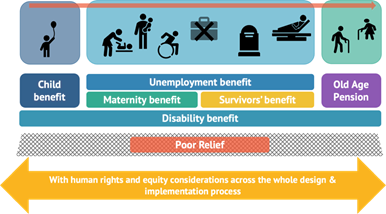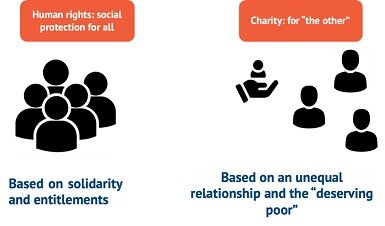Now, more than ever, human rights considerations are vital for social protection responses to COVID-19
Alexandra Barrantes
 Never has the need for a human rights-based approach to Social Protection been more urgent as in times of COVID-19. This approach entails framing social protection debates and policy decisions around entitlements rather than charity or handouts.
Never has the need for a human rights-based approach to Social Protection been more urgent as in times of COVID-19. This approach entails framing social protection debates and policy decisions around entitlements rather than charity or handouts.
The rights to social security[2] and a minimum standard of living are enshrined in both universal and regional human rights frameworks.[3] As such, States become duty-bearers and individuals are understood as rights-holders entitled to enjoy this right. So, beyond the unavoidable fact of human rights being legally binding, why are human rights considerations fundamental to building inclusive and lifecycle social protection systems, in particular given our current circumstances of a pandemic?
Guiding principles and standards
 Human rights provide a framework for the design and implementation of social protection programmes, services and policies through human principles and standards. Some of the principles and standards that social protection policy-makers should bring to the table when designing, assessing and implementing programmes and policies are included in figure 1[4].
Human rights provide a framework for the design and implementation of social protection programmes, services and policies through human principles and standards. Some of the principles and standards that social protection policy-makers should bring to the table when designing, assessing and implementing programmes and policies are included in figure 1[4].
Given the current COVID-19 crisis, it is key that technological solutions at the service of social protection responses take into consideration human rights principles such as the right to privacy and confidentiality of data.
Lifecycle perspective
 An inclusive lifecycle social protection system (see figure 2) requires governments to base their policy design and programme implementation on human rights principles and build national legal and regulatory frameworks that acknowledge the right to social protection and the right to an adequate standard of living. Since individuals of all ages are rightsholders and vulnerable to shocks and risks of different types (including pandemics), governments need to ensure that people are covered throughout their lifecycle, making sure dignity is at the core of any social protection system.
An inclusive lifecycle social protection system (see figure 2) requires governments to base their policy design and programme implementation on human rights principles and build national legal and regulatory frameworks that acknowledge the right to social protection and the right to an adequate standard of living. Since individuals of all ages are rightsholders and vulnerable to shocks and risks of different types (including pandemics), governments need to ensure that people are covered throughout their lifecycle, making sure dignity is at the core of any social protection system.
Inclusivity
 As the evidence from several low and middle income suggests, poverty targeting instruments are still very arbitrary and are not able to achieve the very objective they were created for: identifying the poorest in a society; as they leave most of those intended beneficiaries behind. There also seems to be an over-focus on inclusion errors instead of concentrating on addressing exclusion. The latter is much more serious from a human rights standpoint. As such, and unlike a social protection approach that focuses primarily on issues around fiscal austerity and the “efficient” allocation of scarce resources by targeting the “poorest of the poor” (which is, in reality, impossible) or “the other,” a rights-based investment in social protection requires Governments to push for the use of the maximum resources available and for a progressive realization of the right to social protection for all (as illustrated in figure 3). This allows for inclusive social protection systems for all, not leaving anyone behind and not just providing for the “deserving” or “the other”. Given the current context of a global pandemic, the inclusivity of social protection systems becomes key.
As the evidence from several low and middle income suggests, poverty targeting instruments are still very arbitrary and are not able to achieve the very objective they were created for: identifying the poorest in a society; as they leave most of those intended beneficiaries behind. There also seems to be an over-focus on inclusion errors instead of concentrating on addressing exclusion. The latter is much more serious from a human rights standpoint. As such, and unlike a social protection approach that focuses primarily on issues around fiscal austerity and the “efficient” allocation of scarce resources by targeting the “poorest of the poor” (which is, in reality, impossible) or “the other,” a rights-based investment in social protection requires Governments to push for the use of the maximum resources available and for a progressive realization of the right to social protection for all (as illustrated in figure 3). This allows for inclusive social protection systems for all, not leaving anyone behind and not just providing for the “deserving” or “the other”. Given the current context of a global pandemic, the inclusivity of social protection systems becomes key.
Shock-responsiveness
Inclusive social protection can build resilience to idiosyncratic risks that affect all of us at different times across the lifecycle. Due to the inclusive nature of universal lifecycle schemes, and the fact that they usually have larger coverage among a certain population (old age, children, persons with disabilities), they are also a more effective response to widespread covariate shocks as support can be rapidly increased to large numbers of the affected population. Universal lifecycle programmes reach a higher proportion of vulnerable households and offer up to date information, hence making a rapid scale-up of transfers possible. The best way to develop shock-responsive social protection programmes is to strengthen the national core social protection system by developing an effective, lifecycle system that guarantees all citizens regular and predictable income transfers. Moreover, within the context of a pandemic, the “deservingness” issue of who should receive government income or some other kind of support, is highly questionable. Many segments of society beyond those that poverty-targeted programmes consider “the poor” or “ultra-poor” are being pulled into income insecurity and vulnerability by losing their jobs as their employers close down. So, what is the best solution? Rights-based, inclusive and universal social protection is the best way forward since pandemics do not choose who falls sick depending on an abstract construct of deservingness. As a matter of fact, pandemics are the consummate ghastly case to show that we are all in the same boat and that everyone is at risk of shocks, crises, diseases and poverty. Hence the need for inclusive lifecycle support from Government.
It is also about the process, not just the policy outcomes
A rights-based approach allows us to look at the entire policy process instead of just the desired outcomes of social protection public policies. As such, “states’ obligations also apply to the content of their social protection policies, as well as in the process by which they implement them.” This includes the design, regulation, and implementation of social protection programmes and systems, from high-level decision-makers through to social workers, street-level bureaucrats and local government officials tasked with on-the-ground implementation. Human rights principles must be applied to the entire process and not concentrate only on the outcome (which might be focused on human development outcomes, income security or poverty reduction, among others). The crux of the matter is for the whole process to incorporate principles such as dignity and non-discrimination, instead of just focusing on the efficiency in reaching the intended outcomes.
If governments and development partners providing policy advice to low and middle-income countries base their social protection provision on negative narratives around poverty and the “deserving and undeserving poor”, instead of focusing on inclusive lifecycle systems, ultimately they are fragmenting service delivery systems based on different audiences (services for the poorest, the non-poor, those more prone to shocks and risks, etc.), and are bound to fail in their endeavour to comply with the Sustainable Development Goals (SDGs) and “leave no one behind.”
This holds true particularly in the midst of the COVID-19 social protection responses countries are trying to grapple with. Leaving no one behind can only be achieved by inclusive systems that incorporate human rights principles and standards, commit to respecting the inherent dignity of every human being, and invest in sound and inclusive systems instead of a palliative poverty-targeted approach.
Alexandra Barrantes is a Senior Social Policy Specialist at Development Pathways and an international development practitioner with more than 20 years of experience in social protection, poverty reduction, inequality, economic, social and cultural rights, and governance. She has experience in high−level policy advice in the social protection and poverty field across Latin America, the Caribbean and Africa. She has formed part of several International technical Working/Advisory Groups on poverty, social protection, SDGs, and social rights with key international stakeholders (including UNICEF, ILO, UNRISD, ECLAC, WB, OPHI, CGAP, among others). She has extensive publications in her field of work.
[1] This blog is a shortened version of a paper by the author published by Development Pathways.
[2] As per Sepúlveda (2014) for this work the concepts of the right to social protection and social security are considered as synomys based on the work of the United Nations Committee on Economic, Social and Cultural Rights (CESCR).
[3] Including the following universal instruments: Universal Declaration of Human Rights articles 22, 25; International Covenant on Economic, Social and Cultural Rights articles 9, 10, 11; Convention on the Rights of the Child article 26; International Labour Organisation Social Protection Floors Recommendation, No. 202, and regional human rights instruments.
[4] All illustrations used in this article were designed by Picture Human Rights in a collaboration between them and Development Pathways in November of 2019.




